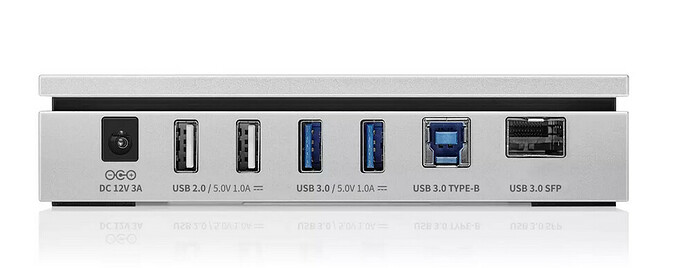So it seems that dCS (and I ![]() ) prefer Ethernet over USB. On the other hand it seems that AES/EBU is the second choice to connect a source to the DAC.
) prefer Ethernet over USB. On the other hand it seems that AES/EBU is the second choice to connect a source to the DAC.
So…would SQ improves with an USB-to-AES converter then?
There are plenty of concerter out there from 50€ to 2000€…
thanks!
Only if it supports an external Clock input ![]()
I haven’t looked lately, but there aren’t that many USB-to-AES/EBU converters in the market that support an external Clock. I have an old one made by exD Audio from years ago, originally designed for the dCS Purcell/Elgar+, which does AES/SPDIF and SDIF2 as well. Unfortunately they’re not made anymore.
Thanks Anup,
what about this?
Mutec MC3+ USB can do the job
MUTEC – Digital Audio Equipment – High End | Professional Audio - MC3+ USB (mutec-net.com)
(USB / Reclocking / AES i/o / SPDIF i/o / clock input up to 10MHz / multiple clock outputs).
thanks Martin- can I connect this to my Rossini Clock then?
No. The Rossini Clock has no clock inputs. So you can neither use the MC3+ USB as a clock master, nor sync both the Rossini Clock and the MC3+ USB to a common 10MHz reference clock (e.g. Mutec Ref10 SE 120). To do this, a Vivaldi Clock would be required.
Syncing the MC3+ USB to the Rossini Clock (via its output 3) would require a manual intervention via RS232, when the sample rate changes from 44.1kHz to 48kHz (not very practical).
So I’d suggest, you just use the MC3+ USB’s internal clock, connect its audio AES or SPDIF output to the Rossini DAC, and sync that input to audio. This way you can use the MC3+ USB either as a reclocker or as a simple format converter.
cool- thanks Martin!
If the AES input on dCS products were indeed to be better than the USB input, wouldn’t the conclusion be that dCS had not done their homework? The USB input is simply a USB to (I guess) i2s converter and i2s would go directly to the DAC. Using a USB to AES converter the path would be USB to AES and AES to i2s.
A question to the experts: how would that be better?
just watched a video from PS Audio where their CEO explains i2s vs other inputs. PS Audio clearly prefers that input type. Same for Metronome Audio (their top transporter AQWO is connected via i2S to DAC). The problem with i2S is that’s not a standard (so their are different pin connections out there f.ex.)
I’d agree Rudi, I think it’s highly debatable whether or not the AES interface is actually better than USB with dCS DACs. I don’t think I’ve seen anyone from dCS claim that the AES interface is a “second choice” after Ethernet.
With respect to this thread though, I think the general idea is about isolation as USB suffers from host compute electrical noise and other issues, which AES typically doesn’t.
So, it’s possible that isolating the USB interface physically into a separate box that only does USB-to-AES conversion, and if the conversion is properly clocked, it might allow AES to potentially sound better than USB.
If this were indeed to be the case, it would seem to me that dCS had not done their homework when designing the USB input. In my book, a DAC with a claim to excellence should not benefit from externally isolating the USB link in whatever form. The input itself should be sufficiently isolated by design.
But I guess this would go under the same heading as expecting an SFP Ethernet input that is perfectly isolated and does not benefit from external switches.
useful for someone with a non dCS dac with a USB out who wants to keep their PC away from their main system perhaps?
I don’t disagree. In any case, I don’t recall dCS ever making any claims about AES being better than USB as such that might warrant external USB isolation.
I’m not sure I understand what you mean… but to be clear, USB has very different electrical and interface characteristics than Ethernet/SFPs; just because the former may benefit from isolation doesn’t mean the latter will.
The last statement was more of a general one in the sense that I would expect a high end manufacturer to build his DACs in such a way that they do not require or benefit from extremal ‘cleaning’ kit.
- sufficiently noise rejecting PSU, not requiring special 230V cables or external power conditioning
- optical ethernet in with a recommended (sufficiently low noise) SFP module
- USB in with sufficient isolation that it is on the same quality level as ethernet
- AES/SPDIF/Toslink input that (with sufficiently good input signal) is as good as ethernet
dCS makes great strides to do just that. With a few more steps the continuing discussions about external optical isolation of ethernet, external USB isolation etc. should become unnecessary.
@Anupc I am aware that you are of the view that the discussions are already unnecessary today.
If there were absolutely zero cost constraints, I think there are possible design/components areas that could reduce the risk of interference further.
Fortunately, I (we?) trust dCS to make the best design decisions (otherwise we won’t own dCS kit) versus ultimate cost-no-object designs which could mean an 8-box flagship instead of 4 ![]()
Sign me up for the 8-box flagship! I feel underinvested in cables (and racks)! ![]()
You are aware that anything you say on the internet is there forever and can therefore be dug up at any point in the future should it ever become convenient…? ![]() :
:
P
or a next gen Vivaldi one sans optical transport. I have a cable phobia
